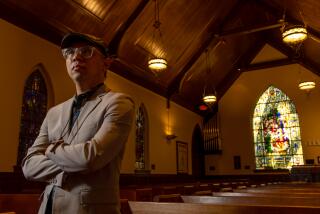Texas Gunman: A Loner, Full of Rage
- Share via
FORT WORTH — From a hundred details of his daily life, it was clear that Larry Gene Ashbrook, who authorities say killed seven churchgoers before committing suicide Wednesday, seethed with hostility, distrusted neighbors and sometimes victimized the vulnerable, including his elderly father.
But though investigators kept combing his shabby, ravaged house and the Wedgwood Baptist Church 10 minutes away, where the carnage took place, they found little to explain why Ashbrook burst upon the church youth rally and calmly sprayed its participants with bullets from two handguns.
No hate writings, no farewell note, no screed in 47-year-old Ashbrook’s out-of-date journals have yet been found to definitively decode his motives, police said. Mostly from the 1980s, the diaries articulate despair and rage at being unable to hold jobs, officials said. Neighbors who saw Ashbrook grow from a sociable schoolboy into a furtive, lank and irritable recluse said he clearly was unwell.
Jobless and antisocial, he seemed financially dependent on his widowed father, retired railroad engineer Jack D. Ashbrook. Perhaps the older Ashbrook’s death about two months ago undid him, some neighbors said.
Others recalled his ire at having to accompany his parents to the Pleasant Ridge Church of Christ in his blue-collar Forest Hill neighborhood. Witnesses who saw Ashbrook for the first time Wednesday said he spewed anti-religious invectives while firing at the congregation. “I can’t believe you believe this junk,” they said he snarled. “This religion is [expletive].”
What authorities did find inside the gunman’s 1960s era ranch house bespoke a man frenzied by violence, a man not expecting to return home. “He virtually destroyed his house,” said FBI Special Agent in Charge Robert Garrity.
Bibles, Family Photos Were Defaced
Boxes of ammunition for his two handguns lay amid the rubble of his belongings. Toilets had been choked with recently bought concrete; walls smashed down apparently with crowbar and shovel. Someone had hurled furniture across the floor. Motor oil clogged the shower heads. Bibles and family photographs were mutilated, according to a detective. “This has the appearance of being a very troubled man,” Garrity said, “who, for whatever reason in his own mind, sought to quiet whatever demons that bothered him.”
Few of those demons immediately were evident in official records, Police Chief Ralph Mendoza said. Although unemployed, Ashbrook had no documented history of mental illness or violence. His one encounter with the law, in 1971, was a misdemeanor marijuana possession charge, whose dispensation is unclear.
Even the two guns he used in Wednesday’s shootings appeared to have been bought legally--one from a large flea market in the Dallas-Fort Worth area, the other from a now-defunct local gun shop, Mendoza said.
On Marshall Street, neighbors were voluble with the details of his existence, as they understood it.
“‘I always told my children, ‘Don’t look over there, Larry’s outside,’ ” said Venita Hord, who lived across from Ashbrook for decades. “You’d wave hello and he’d glare at you, if he looked at you at all.”
He hated being noticed, other acquaintances concurred. “What are you looking at?” Ashbrook would bark at neighbors he had known for years.
Once, three or four years ago, when Hord and her daughter, Janet Gabhart, were relaxed and joking on their front lawn, they abruptly felt Ashbrook’s hostile gaze.
“He must have thought we were laughing at him, but we weren’t,” said Gabhart. “He took his [penis] out and shook it at us.”
Neighbor Mary Thomason said that, as a boy, Ashbrook “was normal” and a playmate of her son’s. His mother, a department store employee, played dominoes with Thomason; his father, longtime family minister Bill Pullen said, was “salt of the earth” and gentle.
Sole School Activity Seen as Art Club
Even so, the family’s one publicly known source of strife appeared to be religion. Neighbors gossiped that Ashbrook bitterly resented accompanying his parents twice weekly to their church.
In his high school yearbook, Ashbrook listed participation in just one activity: the Art Club. But the club’s then-sponsor, Tom Kearley, could not recall him, and school records do not document if Ashbrook graduated.
Then in 1971, he enlisted for four years in the Navy. After he returned from a posting in Florida, Thomason said, “he changed. I don’t know what happened.”
But her husband, Earle, traced their neighbor’s odd behavior to 1990, when Ashbrook’s mother died. Ashbrook retreated into seclusion, and his brother and two sisters stopped visiting him.
His habits, neighbors said, grew stranger. At one point, neighbors thought the skinny, stringy-haired recluse worked with remote-controlled toy airplanes, which he occasionally hauled from what looked to be a 1985 Chevy Impala.
He scuttled in and out on other, more cryptic errands, gripping a blue double-handled bag shaped like a bowling bag.
When his siblings arrived for his father’s funeral this summer, the gulf between them and their brother was unmistakable. Ashbrook was disheveled, wearing jeans and a T-shirt; his brother and sisters wore clothes suitable for church.
“It was like he was the ugly duckling,” Mary Thomason said. After that, she added, “they didn’t come by . . . . I think they could have helped Larry after his father died, but they didn’t. He needed help.”
A man who answered the telephone at Ashbrook’s brother’s house in Rhome, Texas, hung up when a reporter called. His sisters could not be contacted. But at a news conference, Chief Mendoza said that family members told authorities following the shootings that Ashbrook showed clear signs of mental illness, “someone that is paranoid, someone who exhibits signs of being schizophrenic.”
Over the summer he wrote at least two rambling letters to the Fort Worth Star-Telegram complaining that he’d been targeted by the CIA. A month ago, he called FW Weekly, a local paper, and told someone, “My back’s against the wall. My father died two weeks ago . . . . I’m not a serial killer . . . ,” he said, according to the paper’s Web site, “although I have always been something of a failure with women.”
The Mysterious Blue Bag
Neighbor Herman Heslip, 23, recalled that the effect of Ashbrook’s constantly worn sunglasses was eerie rather than fashionable.
Clustered on Hord’s front lawn the day after the shootings, neighbors from this working-class, interracial neighborhood swapped memories of their last sightings of Ashbrook and speculated about the blue bag’s contents.
They also reflected on Ashbrook’s other distinctive trait: his propensity for fury, whether it was directed toward inanimate objects or his own father.
They recalled the edge in his voice when Hord set out a slip-and-slide water toy on her front lawn. “You’re frustrating me!” he barked. He never simply shut a car or house door; he kicked them open angrily.
And despite his dependence on Jack Ashbrook, neighbors said, Larry openly mistreated him, both verbally and physically.
“He was mean to his daddy,” Gabhart said. “You could hear him hollering . . . . He would just cuss his daddy out. You used to worry about his daddy, why he would put up with that.”
Several times, the Hords said, they saw Ashbrook shove his father; once, when he got locked out of his house, he pushed the elderly man to the ground when he unlocked the door.
Neighbors Feared for Their Safety
But they never alerted police or social service workers, neighbors said, because they feared retaliation.
So cowed was she by her gaunt and hostile neighbor, Venita Hord barely looked up the last time she saw Ashbrook, around 4 p.m. Wednesday.
“He was messing around with the hose and the hydrant,” she recalled, gesturing to the cedar tree near Ashbrook’s aqua-trimmed garage door. And he was wearing jeans and a T-shirt. But she didn’t look any further at the neighbor who for so long had made his presence known by kicking doors and shouting.
A few hours later, he was pounding on another door and barking at a different group of people, this time inside the Wedgwood Baptist Church. Within moments, he had fired about 30 rounds, killing seven people and wounding seven more. Then he sat back down among them, in a pew, and turned one of the two guns against his head.
(BEGIN TEXT OF INFOBOX / INFOGRAPHIC)
Retracing the Rampage
The path of Larry Gene Ashbrook, the Texas man who gunned down teenage worshipers and others at a Baptist youth service Wednesday.
1. Ashbrook enters church carrying 9-mm semiautomatic handgun.
2. He fatally shoots a maintenance man and a young man selling CDs, then turns gun on children’s choir director Sydney Browning.
3. Gunman then enters sanctuary, where he paces and curses while choir rehearses.
4. Gunman begins firing into crowd on stage and those waiting to rehearse a skit.
5. As church members dive for cover, Ashbrook roams aisles, killing four.
6. Ashbrook pulls pipe bomb from his pocket, lights fuse and rolls it toward the stage.
7. As police arrive, Ashbrook walks back to pew, sits down and turns gun on himself.
Sources: Times staff and wire reports, Fort Worth Star-Telegram, Fort Worth Fire Department.
More to Read
Sign up for Essential California
The most important California stories and recommendations in your inbox every morning.
You may occasionally receive promotional content from the Los Angeles Times.













